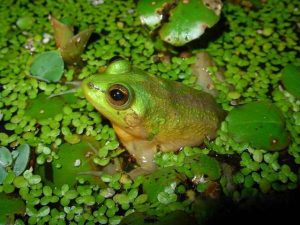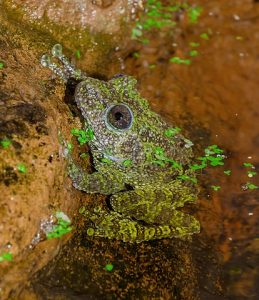Strange Animals Podcast

Episode 414: Two Marvelous Frogs
Thanks to Eilee and Alexis for their suggestions this week, two amazing frogs!
Further reading:
Paradoxical frog: The giant tadpole that turns into a little frog
Fungus is wiping out frogs. These tiny saunas could save them.
The paradoxical frog [photo by Mauricio Rivera Correa – http://calphotos.berkeley.edu, CC BY-SA 2.5, https://commons.wikimedia.org/w/index.php?curid=6703905]:

The Vietnamese mossy frog [photo by H. Zell – Own work, CC BY-SA 3.0, https://commons.wikimedia.org/w/index.php?curid=81804225]:

Show transcript:
Welcome to Strange Animals Podcast. I’m your host, Kate Shaw.
Let’s start 2025 off right with an episode about frogs! Thanks to Alexis and Eilee for their suggestions.
Let’s start with Eilee’s suggestion, the paradoxical frog. The paradoxical frog is a type of tree frog that lives in South America. Like other frogs, it likes ponds and shallow lakes. Some individuals are green and some are brown, and a frog may have darker stripes or splotches, or might just be plain. The tadpoles eat algae and other tiny food, while the adults eat insects.
As with most frogs, the paradoxical frog hatches into a larval stage called a tadpole or pollywog, which is fully aquatic. It later metamorphoses into its adult form as a frog. Most tadpoles start out very small and grow larger, then metamorphose into a juvenile frog which then grows to fully adult size. But while the paradoxical frog’s tadpole starts out small, it can grow to as much as 11 inches long, or 28 centimeters! It’s the largest tadpole in the world as far as we know.
So how big is the adult frog if the tadpole is so enormous? About 3 inches long, or 7.5 cm, from snout to vent. That’s why it’s called the paradoxical frog, because a paradox is something that seems contradictory to expectations. Instead of the ordinary way of things, where a small tadpole grows into a bigger frog, in this case a big tadpole grows into a smaller frog. It’s sometimes called the shrinking frog.
One interesting detail is that not all of the tadpoles are that big. If a female lays her eggs in a small body of water that’s likely to dry up, or that doesn’t have a lot of food available, or if there are a lot of predators in the water, the tadpole metamorphoses quickly and doesn’t grow very big. But if the tadpole is in a better location it matures much more slowly, which allows it to reach much larger size before metamorphosing.
I should also mention that the 11-inch-long tadpole that is the largest ever measured was actually raised in captivity. In the wild, the largest paradoxical frog tadpole ever measured was 6 ½ inches long, or almost 17 cm. That’s still really big, but not that ridiculously big. But the confusing thing is that the tadpole is big and bulky, up to four times the size of the adult frog. Where does all that mass go after it transforms?
Early scientists who learned about the paradoxical frog wondered the same thing. They were so confused that they suggested that the frog actually came first and later metamorphosed into the tadpole, which then metamorphosed into a fish. But the main reason the tadpole is so long is its tail. When it metamorphoses into a frog, it absorbs the tail and therefore appears to shrink. The bulkiness of the tadpole’s body matches the bulkiness of the frog’s body. And unlike most frogs, which metamorphose into juvenile frogs that still have some growing to do, the paradoxical frog metamorphoses into a completely adult frog. It’s as big as it will ever get and fully mature, ready to mate and lay eggs.
Next, Alexis wanted to learn about the Vietnamese mossy frog. It lives in parts of Vietnam, Laos, and other nearby areas. It prefers mountainous rainforests and the female often chooses to lay her eggs in a tree hollow or even a rock cavity where water has collected. Instead of laying her eggs in the actual water, though, she lays them on rocks or branches above the water. The eggs don’t dry out because of the high humidity in rainforests, and when they hatch, the tadpoles fall into the water.
The tadpoles take a long time to mature, anywhere from four to eight months depending on how warm it is while they’re developing. They grow quite large, although not anywhere near the size of the paradoxical frog tadpole.
A big female Vietnamese mossy frog can grow up to 3 ½ inches long, snout to vent, or 9 cm, and is chubby and round. It’s nocturnal and spends the day hiding on mossy rocks or among plants in the water, then comes out at night to hunt insects like crickets as well as other small animals like worms.
The reason it’s called the mossy frog is because it looks for all the world as though this frog is covered in moss, or maybe is just made out of moss. It’s green and brown in color and its skin is covered in little bumpy structures called tubercules. This helps it blend in incredibly well in the rainforest, where moss is pretty much everywhere. If it feels threatened and it can’t jump into the water to hide, it will play dead.
This is what a Vietnamese mossy frog sounds like:
[frog beeping]
As we’ve talked about in other frog episodes, frogs throughout the world are declining in numbers because of a fungus that infects their skin. The effects of this fungus are worse in cold weather, so a team of scientists speculated that helping the frogs stay warm might help them stay healthier in winter and even help them recover from the infection. They tested their hypothesis by offering infected frogs a variety of temperatures in their enclosure. The frogs could pick where they wanted to spend their time. The frogs liked the warm areas but didn’t spend all their time in them, but they all recovered from the infection. Frogs who were given an overall warm environment also recovered, but not as fast. Frogs who had an ordinary enclosure without warmer areas remained infected with the fungus. Even better, frogs who had recovered from infection with the warm environment also showed resistance to later infections.
The team worked to develop plans that allow people to easily build what they call frog saunas. They don’t require electricity or fuel, just sunshine. When the saunas are placed near ponds or other areas with frogs, the frogs find them quickly and use them. There’s a link in the show notes if you want to learn how to make a frog sauna for your own back yard.
You can find Strange Animals Podcast at strangeanimalspodcast.blubrry.net. That’s blueberry without any E’s. If you have questions, comments, or suggestions for future episodes, email us at strangeanimalspodcast@gmail.com. We also have a Patreon at patreon.com/strangeanimalspodcast if you’d like to support us for as little as one dollar a month and get monthly bonus episodes.
Thanks for listening!






 Visit Podcast Website
Visit Podcast Website RSS Podcast Feed
RSS Podcast Feed Subscribe
Subscribe
 Add to MyCast
Add to MyCast